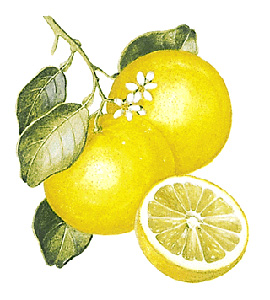Grapefruit is a large, round citrus fruit. People in many parts of the world enjoy grapefruit for breakfast. They also drink the tart, somewhat bitter juice of the fruit. Grapefruit probably got its name because some varieties produce fruit in clusters, like grapes.

A grapefruit measures 4 to 6 inches (10 to 15 centimeters) in diameter. It consists of 10 to 14 segments surrounded by a soft white inner rind and a leathery yellow outer rind. The segments contain pulp, juice, and seeds, though most commercial varieties of grapefruit have few or no seeds. The fruit is rich in vitamin C.
The pulp and juice of grapefruit range in color from white to pink or red. The white-fleshed, seedless Marsh grapefruit is the most important white variety. A well-known pink variety is the seedless Thompson, also known as the Pink Marsh. An important red grapefruit is the seedless Redblush, also known as the Ruby. The flesh and, in some cases, the rind of pink and red varieties have a pink tinge. All varieties of grapefruit have a similar taste and texture.
China produces about half of the world’s grapefruit. Mexico, South Africa, the United States, and Vietnam rank next in production. Growers in the United States harvest about 1.1 billion pounds (500 million kilograms) of the fruit yearly. California and Florida are the nation’s leading grapefruit producers. About half of the United States crop is processed into juice or fruit sections to be canned or frozen.
Growing grapefruit.
The grapefruit tree can grow to a height of about 30 feet (9 meters). It has dark green leaves and white flowers. The trees are grown from the buds of other grapefruit trees that produce the variety of grapefruit desired (see Grafting (Other kinds of grafting)). The fruit, which appears in 3 to 4 years, develops from the ovaries of the blossoms. It is harvested 8 to 14 months after the flowers bloom.

Grapefruit trees and fruit may be severely damaged by frost and cold temperatures. The trees also may be attacked by such pests as mites, aphids, and scale insects. Growers control these pests by spraying the trees with insecticides. In addition, they spray with fungicides to protect the leaves and fruit from fungus diseases, including greasy spot, melanose, and scab.
In the United States, federal and state laws establish standards of maturity for grapefruit. As grapefruit matures, the sugar and juice in the fruit increase, and the acid decreases. The fruit does not mature further after being harvested. Therefore, growers pick grapefruit when it contains the required amounts of sugar, juice, and acid.
History.
Grapefruit probably originated in the Caribbean region in the early 1700’s. Scientists believe it developed as a natural hybrid of the shaddock, or pomelo, a citrus fruit of Southeast Asia. The first grapefruit trees in Florida were planted about 1820. By 1900, the fruit was being shipped throughout the United States.
